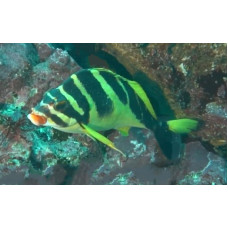Latin name
Goniistius zebra
Other name
Goniistius zebra
Identification
They have an oval, compressed body. The redlip morwong has thick fleshy lips, a bony spur, a steep dorsal profile of the head and a deep body. Gill stamens are 5+12.
Features of fish fins
The dorsal fin has 14-17 spines and 29-35 soft rays, while the anal fin contains 3 spines and 8-12 soft rays, the pectoral fins have 14 rays, of which the 6 lowest rays are simple and stout.
Fish colouring
The body is pale, almost white, with 9 dark oblique stripes. The first 3 are on the head. The first goes from the end of the snout to the corner of the pre-cranial bone, the second crosses the eye and goes to the base of the pectoral fin, the third goes from the back of the head to the base of the pectoral fin, the fourth to sixth start at the barb on the dorsal fin and end below the lateral line. The ninth stripe crosses the base of the caudal fin and runs along its lower lobe.
Distribution
Widespread in the Pacific Ocean: Easter Island, Japan and Taiwan.
Habitat
A marine, reef associated species that prefers temperate climates.
Size
The maximum length of these fish is 22.1 cm.
Behavior
Red-lip morwongs are found in rocky areas and are nocturnal.
Food and feeding habits
They feed on benthic invertebrates picked up from the substrate.
Reproduction
This species does not guard its eggs.
Fishing
This species is commercially important in fisheries.
Relationship with a person
Harmless.
| Classification | |
| Phylum | Chordata |
| Class | Actinopterygii |
| Squad | Centrarchiformes |
| Family | Cheilodactylidae |
| Genus | Goniistius |
| Species | G. zebra |
| Features | |
| Conservation status | Not Evaluated |
| Habitat | Pelagic |
| Life span, years | No information |
| Maximum body weight, kg | No information |
| Maximum length, cm | 22,1 |
| Sailing speed, m/s | No information |
| Threat to people | Not edible |
| Way of eating | Planktonophage |
Redlip morwong
Tags: redlip morwong



